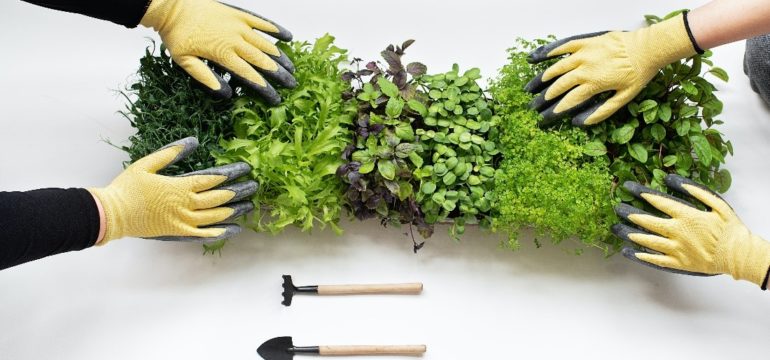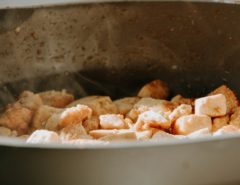Microgreens and Food Safety
By: Allyson Hamilton
A group of researchers, including the present author, recently surveyed and interviewed ~50 microgreen growers in the United States to better understand the common microgreen growing practices, hurdles, and food safety concerns related to consumption. The knowledge relevant to consumers that was acquired during the research process follows.
Microgreens are immature plants harvested just after the first set of true leaves have developed. Microgreens, sometimes termed, “vegetable confetti,” can have many different colors, flavors, and textures, depending on the species of seed being grown [1]. The majority of restaurants use microgreens as a garnish, while some consumers and restaurants utilize them as the main ingredient of salads and other vegetable dishes. Many proponents of microgreen consumption tout the health benefits and claim that microgreens may be even more dense in nutrients than their mature vegetable counterparts [1]. The American Chemical Society recently published data in the Journal of Agriculture and Food Chemistry that suggests microgreens may contain up to forty times more nutrients (such as Vitamin C, E, K, and beta-carotene) than their full-sized counterparts on a per-weight basis [2].
Any edible plant can be grown as a microgreen. Common examples of plants grown for consumption as a microgreen include peas, basil, radishes, sunflowers, amaranth, mustard, and many others. Inedible plants, such as those from the nightshade family (tomatoes, potatoes, eggplants, and peppers) should not be consumed as microgreens because they contain toxic alkaloids such as solanine and tropanes that can damage the nervous and digestive systems [3-4].
Microgreens can be cultivated traditionally in soil, in a soilless matrix, in a hydroponic system, or in an aquaponic system. Soil alternatives for the cultivation of microgreens using a growing medium include substrates such as tree bark, rice husks, sawdust, wood chips, coco coir, fleece, grape pomace, sugar cane fiber, peat, hemp, jute, perlite, glass wool, clay, gravel, sand, rock wool, zeolite, and vermiculite [3-4].
When microgreens reach 1 to 3 inches (8-25 days), depending on variety, the stem is cut just above the soil line using clean scissors or a knife. Microgreens are rarely washed by producers to avoid issues with mold, so they should be washed before consumption by the consumer [3-4]. Sprouts are often confused with microgreens: sprouts are different from microgreens in that they are grown in pure water without light. The growing period for sprouts is shorter than for microgreens (4-10 days), and they are not cut before harvesting, so the root is consumed in addition to the stem and cotyledon. Notably, true leaves have typically not formed when sprouts are consumed. Sprouts often are a pale-yellow color, while microgreens are green due to their exposure to light. While all of the same varieties of plants can be grown as sprouts or microgreens, the growing process and timelines are very different. Commonly sprouted seeds include mung bean, radish, broccoli, wheat grass, and alfalfa [3-4].
Food safety is always a concern with fresh produce. Food safety recalls of microgreen products have occurred every year for the last three years, due to concerns about Salmonella contamination [5-7]. Microgreens are specifically concerning in regard to food safety because the ideal temperature and humidity for growing microgreens is 20°C and 80%, respectively [4]. These environmental conditions are conducive to both mold and pathogen proliferation, indicating the importance of sanitary growing, harvesting, transportation, and storage practices. Especially important, is maintaining the cold chain by keeping microgreens refrigerated before consumption. Notably, microgreens are easily damaged, like other leafy greens, by extreme cold, so care should be taken to verify that storage temperatures remain between 32°F and 41°F degrees, as mandated by the 2009 FDA Food Code [8]. Once harvested, microgreens should be consumed within 10-12 days [8].
- Andrews, A. N. (2013). Enjoy healthful microgreens grown year-round. College of Agriculture, Biotechnology & Natural Resources. Retrieved January 2, 2023, from https://extension.unr.edu/publication.aspx?PubID=2118
- Xiao, Z., Lester, G. E., Luo, Y., & Wang, Q. (2012). Assessment of vitamin and carotenoid concentrations of emerging food products: Edible microgreens. Journal of Agricultural and Food Chemistry, 60(31), 7644–7651. https://doi.org/10.1021/jf300459b
- Treadwell, D. D., Hochmuth, R., Landrum, L., & Laughlin, W. (2020, November 16). Microgreens: A New Specialty Crop. University of Florida Institute of Food Science Extension. Retrieved January 2, 2023, from https://edis.ifas.ufl.edu/publication/hs1164
- Rusu, T., Moraru, P. I., & Mintas, O. S. (2021). Influence of environmental and nutritional factors on the development of lettuce (Lactuca sativa L.) microgreens grown in a hydroponic system: A Review. Notulae Botanicae Horti Agrobotanici Cluj-Napoca, 49(3), 12427. https://doi.org/10.15835/nbha49312427
- Food Safety News (FSN). (2022, December 26). Wegmans recalls certain Greens after soil products grown in test positive for salmonella. Food Safety News. Retrieved December 31, 2022, from https://www.foodsafetynews.com/2022/12/wegmans-recalls-certain-greens-after-soil-products-grown-in-test-positive-for-salmonella/
- Food Safety News (FSN). (2021, November 10). Third Company recalls microgreen seeds because of Salmonella concerns. Food Safety News. Retrieved December 23, 2022, from https://www.foodsafetynews.com/2021/11/third-company-recalls-microgreen-seeds-because-of-salmonella-concerns/
- Food Safety News (FSN). (2020, September 23). More microgreens recalled in relation to Salmonella outbreak. Food Safety News. Retrieved December 23, 2022, from https://www.foodsafetynews.com/2020/09/more-microgreens-recalled-in-relation-to-salmonella-outbreak/
- Beecher, C. (2010, September 29). Cut salad greens: How cold is cold enough? Food Safety News. Retrieved January 2, 2023, from https://www.foodsafetynews.com/2010/09/greens2/#:~:text=FDA%20food%2Dsafety%20officials%20say,%2C%20Salmonella%2C%20and%20Listeria%20monocytogenes.
- Featured Image: https://www.pexels.com/photo/microgreens-on-white-table-8543138/
 Allyson N. Hamilton | LinkedIn
Allyson N. Hamilton | LinkedIn
SMF Blog Writer
Allyson received her B.S. in Chemistry at Indiana University Bloomington. She is currently pursuing her PhD in Food safety at the University of Arkansas. Allyson also works as an English as a second language tutor for Chinese students and enjoys reading and writing about all things FOOD in her spare time.






Leave a Reply